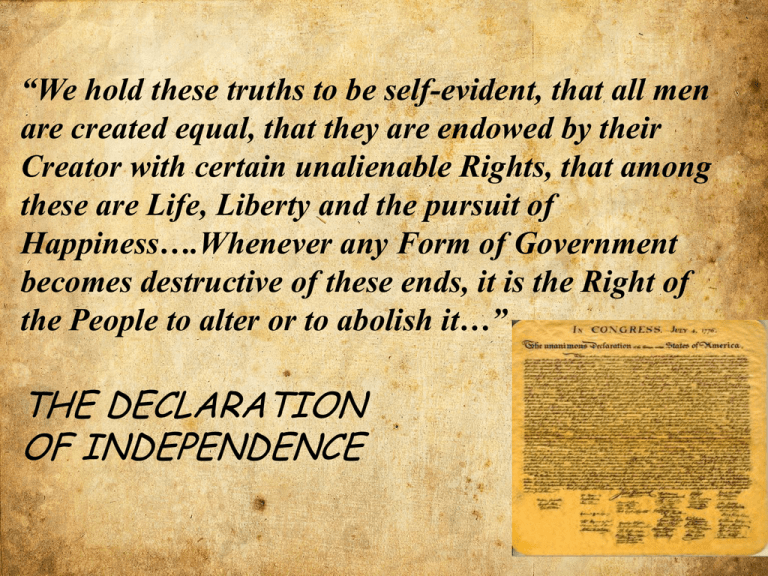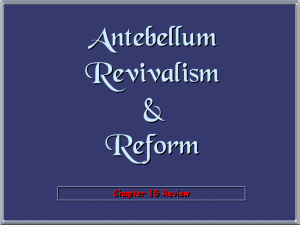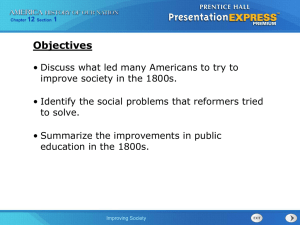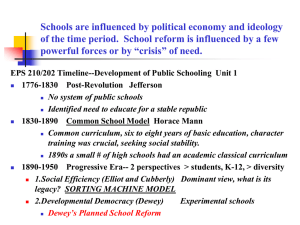AN ERA OF REFORM
advertisement

“We hold these truths to be self-evident, that all men are created equal, that they are endowed by their Creator with certain unalienable Rights, that among these are Life, Liberty and the pursuit of Happiness….Whenever any Form of Government becomes destructive of these ends, it is the Right of the People to alter or to abolish it…” THE DECLARATION OF INDEPENDENCE • http://www.youtube.com/watch?v=nrvpZxMfKa U&feature=related CAN YOU THINK OF any time in history when those famous words of the declaration of independence were not necessarily true? THE 1800s AN ERA OF REFORM WHAT DOES IT MEAN TO REFORM? • To reform something means to change it… Reform Movement Between about 1820 and 1850, American reformers devoted themselves to such causes as ending slavery, promoting women’s rights, protecting the mentally ill and improving education. Great changes in America were about to happen and reformers were fighting for this change. The Second Great Awakening For many people, the feeling of needed to reform or change American society began with new religious movements. One of the main religious movements was called the Second Great Awakening. Optimism of the Second Great Awakening Preachers during the Second Great Awakening began telling their flocks that they could “build a heaven on Earth” through doing good deeds. This inspired people to work for the improve problems in society. Ideas Affect Reform • Many people in society were encouraged by these religious movements to reform (change) problems in society. Others were inspired by the nonreligious ideas of American writers, poets, and philosophers. Temperance Movement Some Americans began the temperance movement. This was a campaign to stop people from drinking alcohol. Many women joined the temperance movement and urged people to sign a pledge to give up alcohol. Temperance Movement Supporters of the temperance movement argued that alcohol was a social ill. Alcohol led to poverty, drunkenness and crime. They believed society would be much better if alcohol was prohibited (outlawed). Many states banned the sale of alcohol. Overtime however, these laws were repealed (taken away). Henry David Thoreau • One famous poet and writer that began to spread his ideas of reform was named Henry David Thoreau. Thoreau preached what he called civil disobedience. CIVIL DISOBEDIENCE Civil disobedience is the idea that people are in control of their government and therefore have to right to do what they believe is right even if it means disobeying the government Breaking Down The Word Civil = peaceful/ nonviolent Disobedience= breaking the rules/ defiance Civil Disobedience= nonviolent acts of defiance that are intended to create change DOROTHEA DIX REFORMING PRISONS AND HELPING THE MENTALLY ILL PRISONERS AND THE MENTALLY ILL • During the mid 1800s prisons were a place to put children accused of petty crimes, the insane and the criminal. Debtors Prison • Over 75,000 Americas were in debtors prisons. Most for over less than 20 dollars. Life in the Prison The prisons were horrible places where people were chained, whipped, beaten, and forced to stand naked in the confining cages. The mentally ill were treated particularly bad and were severely punished if they missed behaved. DOROTHEA DIX One of the most famous people to speak out for the rights of prisoners and the insane was a woman named Dorothea Dix. Dorthea Dix wrote about the horrible things she saw in the prisons and worked tirelessly to improve the conditions in the jails. I have observed mentally ill inmates chained naked to stone walls in cells without heat or ventilation. I have to do something for them. Dorthea Dix and Mentally Insane Through the reform work of Dorthea Dix, the government created new laws to handle children and the mentally insane within prisons. More insane asylums were build to house the mentally ill. In the asylums they were treated as people with an illness, not as criminals. The New Asylums • http://www.pbs.org/wgbh/pages/frontline/sho ws/asylums/view/ EDUCATION REFORM Reforming Education Before the reform movements of the mid-1800s most children did not go to school. The children of many poorer families needed to work and earn money. Horace Mann A man named “Horace Mann” led a movement to reform education. Horace Mann believed that more children needed to be given the opportunity to attend school. Horace Mann argued that education was the “great equalizer” and “greatly improve America.” Horace Mann Horace Mann has become known as the “father of public education.” Horace Mann Reforms Education Horace Mann argued that everyone in society would benefit from children going to school and that people should pay taxes to fund schools, and pay teachers better. School Not For Everyone After his reform actions, most white children, especially boys, attended free public schools. It took many more years for girls and later African-American students to have access to free/public education. It was illegal to even teach a slave to read and write. WOMEN’S RIGHTS THE SUFFRAGE MOVEMENT Equal Rights for Women In the 1840s women were fighting for the rights of others and began to realize they too needed equal rights. 19th Century Women’s Rights During the 1800s women were not treated equally and had little say over their own lives. Divorce was almost unheard of, women couldn’t control the money they earned, they couldn’t vote, and they didn’t have the right to buy or control their own property. THE SENECA FALLS CONVENTION The Seneca Falls Convention • On July 19, 1848, almost 300 people (including 40 men) met in Seneca Falls, New York to discuss women’s rights. • The convention for women’s rights was led by Elizabeth Cady Stanton. She read a speech called the Declaration of Sentiments. The Declaration of Sentiments The Declaration of Sentiments which was read at the Seneca Falls Convention proposed rights of women. It began with these words, “We hold these truths to be self-evident that all men and WOMEN are created equal…” Declaration of Sentiment Just like the Declaration of Independence listed the acts of tyranny (cruelty) by King George over the colonies, The Declaration of Sentiment listed the acts of tyranny by men over women. ELIZABETH CADY-STANTON WOMEN’S SUFFRAGE • Many women argued that they needed to fight for women’s suffrage. Suffrage means the right to vote. They believed this was the best way to get power in society and create change. The Legacy of the Seneca Falls Convention • Only one of the 200 women who participated in the Seneca Falls Convention lived long enough to vote for president. However, The convention represented a great movement towards reforming the rights of women and slowly women began to earn the rights they deserved. • http://www.amazon.com/Not-Ourselves-Alone-ElizabethStanton/dp/B002PMRSWE/ref=pd_vodsm_B002PMRSWE Women’s Rights Convention Suffrage Song “Let us all speak our minds” • http://dig.lib.niu.edu/gildedage/songs/letus allspeak.html Sojourner Truth “AINT I A WOMAN” • One of the women that became an active campaigner for the rights of women and the rights of African-Americans was named Sojourner Truth. • Being both an African- American and a woman, Sojourner Truth represented two of the most oppressed groups in society. Abolitionists work to End Slavery • Another reform movement that existed in the 1800s was the push to end slavery. • During the reform movements of the 1840s, many people became known as abolitionists. They wanted to abolish (end) slavery. • Some of most famous abolitionists include, Sojourner Truth, Harriet Tubman, and Sojourner Truth • Her words of strength and bravery in the face of unspeakable discrimination motivated the thousands who heard her speeches. She represented two great reform movements. “Ain’t I a Woman?” • One of her most famous speeches was given to a church congregation who had gathered together to discuss women’s rights. • Sojourner Truth walked to the front of the crowed as they talked about the rights of white women and stated….. “Ain’t I a woman…” AINT I A WOMEN Abolitionists work to End Slavery • Another reform movement that existed in the 1800s was the push to end slavery. • During the reform movements of the 1840s, many people became known as abolitionists. They wanted to abolish (end) slavery. • Some of most famous abolitionists include, Sojourner Truth, Harriet Tubman, and








